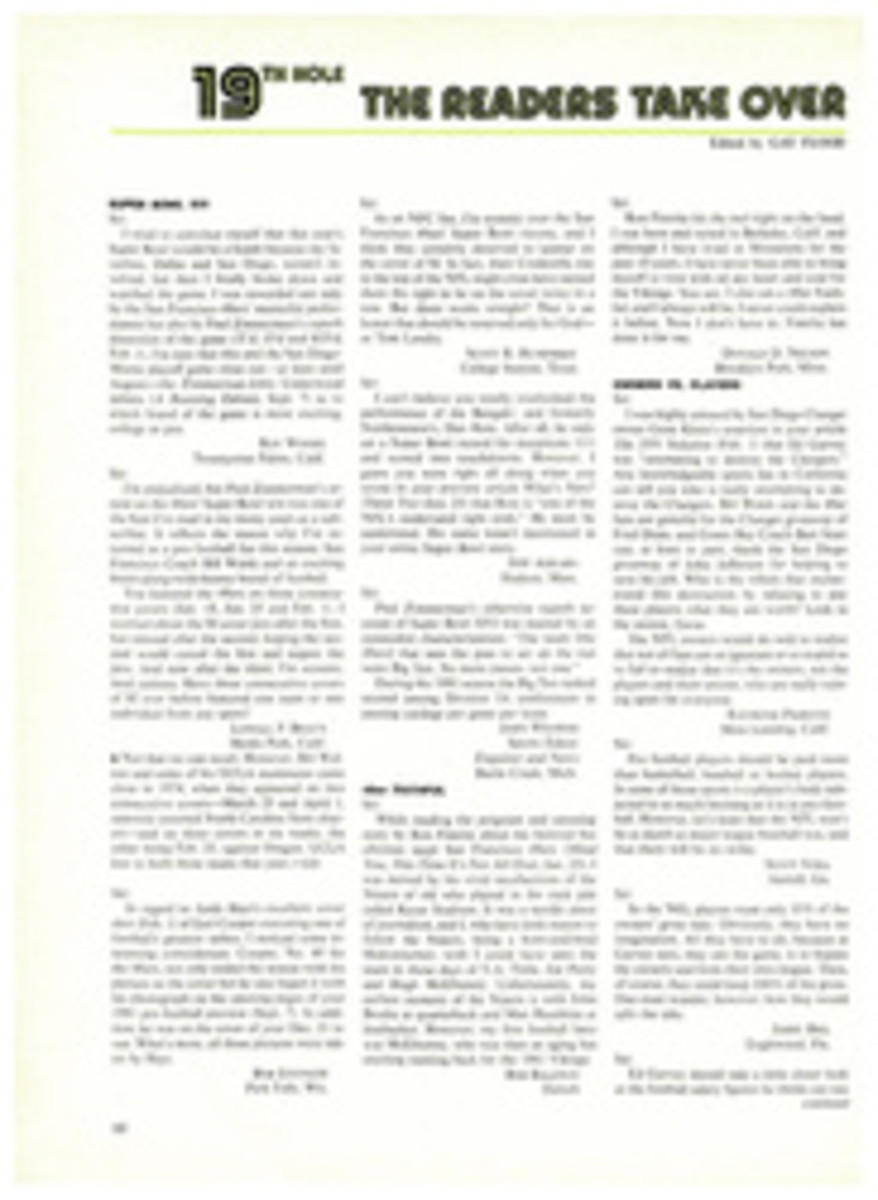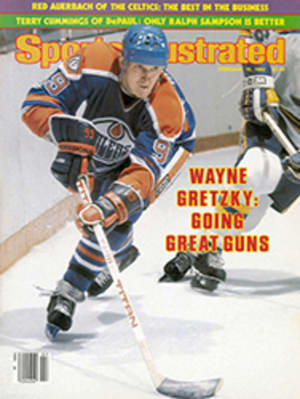
Simply Simons At The Crosby
There was some evidence at the Bing Crosby National Pro-Am last week that professional golf might be headed for the boutiques as a kind of traveling arts and handicraft exhibit. Out there on the Monterey Peninsula at what is the biggest and most important event of the winter, a lot of golf balls were dressed louder than the players, and they kept making these orange and lime-green streaks through the air. And then Jim Simons, the man who eventually won the tournament with a dramatic surge in the late-going Sunday afternoon, began showing everyone up with a trusty little driver and a three-wood made out of oyster-colored metal. Next: Jack Nicklaus lip gloss for talking to putts that won't drop.
The 41st annual Crosby was quite a competition despite the interior decorating jokes and despite the fact that it looked like no tournament at all with only 11 holes left to play. This was the point at which the beefy and often irate Craig (Walrus) Stadler—no designer, he—led the quiet Simons and everybody else by five strokes.
The only question then seemed to be whether anything would be left of the Pebble Beach course when Stadler got through chewing on it. He had taken command of the tournament on Saturday by plowing under Cypress Point with a 64, and through the first seven holes at Pebble on Sunday he was five under for the day and making it suddenly seem as if the USGA had made a horrible mistake in scheduling this June's U.S. Open there.
Stadler, however, is a long-hitting golfer who is big on smoldering tantrums, and his game can suddenly go bad. This doesn't normally happen to him in the middle of a round, however. He's a dependable front-runner and had already won the Tucson Open this year. But Pebble Beach, which had been disarmed by glorious weather all week and was playing rather easily, got in a couple of counterpunches against Stadler at a time when Simons was slowly and quietly working his way toward a round of 66.
Stadler gave Simons a glimmer of hope by hooking his drive into a fairway bunker and then stumbling to a double bogey on the 9th hole, one of those splendid par fours that sits out there on Abalone Bluff, which is the Amen Corner of Pebble Beach. There was then a birdie-bogey swing between the two men at the 14th hole, and that brought Simons from one behind to one ahead, and seemed to promise a finish tighter than the waist on Stadler's trousers.
The whole thing was finally settled on the scenic par-3 17th when Stadler, using a four-iron off the tee, hit another hook, this one almost going into a gift shop in downtown Carmel, and Simons nailed a three-iron that almost went into the hole.
Before he hit, Simons didn't know exactly where Stadler's ball had wound up, which was down in an unplayable lie on the rocks near the ocean. Simons sized up his shot as a three-iron all by himself. "Craig's intimidating because he's so long," said Simons later. "There's no point in my looking in his bag to see what clubs he uses."
Stadler put a terrible swing on the shot that brought him to ruin. It was sort of a violent gouge, and his hand came off the club on the follow-through. Right away he knew it was a goner, and he muttered one of those phrases of his that you'd never come across in children's literature. Afterward, the Walrus tried to explain what he had done to the shot. "I double-crossed it," he said.
Stadler did a good job of not biting off the handle of his club, and after taking a one-stroke penalty drop, he did an even better job of salvaging a bogey 4. But it would do him no good because Simons sank his 6-foot birdie putt, and the tournament was history. With a two-stroke lead, Simons safely parred the 18th for his record-setting total of 274, which was 14 under par for the two rounds on Pebble Beach plus one round each played at Cypress Point and at Spyglass Hill.
If this was the boutique Crosby, it was probably fitting that Simons wound up being the winner because he is—seriously, folks—legally blind. Simons is now in what you call a "piggyback" situation in which he has to wear two contacts—a soft one and a hard one—in his left eye. (The vision in his right eye is still being corrected by a single lens.) Somehow, during the tournament, the soft contact, the inner lens on his left cornea, had dried out, preventing oxygen from reaching the eye. The condition was very painful. Nor was his frame of mind improved by the misery caused by tendinitis in his left shoulder.
On Saturday night, before the final round, Simons spoke to three doctors. He had finished his third round 71 at Spyglass with literally only one eye, because he had been forced to remove both contacts from the left eye to ease the pain. He used eyedrops all through the night, and between shots on Sunday, when the overcast mercifully dimmed the sun, he put on a pair of dark glasses.
Simons has had a reputation for being a slow player. He has speeded up some over the past two or three years, but he still can stand over a putt so long the gallery will be on the verge of screaming. Well, if a man can't see....
Simons hasn't had any outrageous success on the tour. This Crosby was only his third tour victory in 11 years. For this reason he recently had become a stockbroker for Shearson-American Express. "I was obviously planning for a different future," he said.
As a golfer, Simons has a stylish swing, but he has always been a woefully short hitter. In length off the tee, he is in the bottom 5% on the TPA tour. This led him to try the weird-looking metal woods. He insists they have added 15 to 20 yards to his distance.
What the orange and lime-green balls are going to add to the game can only be answered by Calvin Klein.
Designer golf balls have been used on the pro tour for a while but nobody paid much attention to them until the first round of the Crosby. That was because a lime-green ball wound up tied for the lead and an orange ball flew into the cup for a hole in one on the most frequently water-colored par 3 in golf, the 16th at Cypress Point.
The lime-green ball belonged to Bruce Lietzke. He shot a six-under 66 with it at Pebble and shared the opening-day lead with Forrest Fezler, who was playing at Cypress. The man who got the ink at Cypress that day, however, was Jerry Pate, one of the finest shotmakers in the game. He has had two victories in majors, the U.S. Open and Amateur, but he's more widely known for having dived into a Colonial Country Club lake after winning at Memphis last year.
Pate was the guy who sent a one-iron cut over the water and then drew it back onto the green and into the cup for an ace on a hole that is generally considered to be a par 3½ because of its length—233 yards—and difficulty. An ace on the fabled 16th at Cypress would be considered a rare deed with any kind of ball. There had been only three of them, and one of them was made by Bing Crosby. Pate's was the first in tournament competition, and his was obviously also the first with an orange ball.
Pate is under contract to Wilson, and he was first approached by the company about using a boutique golf ball several years ago, the theory being that perhaps a colored ball, as in tennis, might be easier to see, to track in flight. Optic Orange was the color Wilson had in mind. Pate said he would use a polka-dot ball for the right amount of money. The ball was approved by the USGA last fall in the middle of the Pensacola Open, which Pate happened to be leading. He thought about switching on that Saturday in Florida, but decided against it. "If I blow this tournament using an orange ball, the press will crucify me," he said at the time.
Pate won at Pensacola with the commonplace white ball and then changed to the orange. He finished out 1981 by tying for second and third in a couple of tournaments in Japan and coming in third in an event in Brazil. Before Pensacola. Pate had used the Optic Orange during practice for the Ryder Cup Matches at Walton Heath near London.
"All I got was heat," Pate said after his ace, recalling the teasing he got in England from his teammates. "I said then that there wouldn't be a white ball left on the tour in five years. Now I make a hole in one at Cypress and I read in the paper where Nicklaus says that!"
Nicklaus did in fact mention that the Easter-egg balls have some virtue. He said he might consider using a Safety Yellow if MacGregor invents it. It would tie in with his Golden Bear logo. It probably shouldn't matter which shade of ball Nicklaus uses; he is, after all, color blind. As he says, greens are grays to him.
Naturally, everybody at the Crosby was asked about the funny balls. Tom Watson said he would consider using a non-white because he is nearsighted and it might be easier for him to follow a shot, but his wife, Linda, promptly said, "I hope Tom will never use a colored ball. A white ball is part of the game's tradition." Watson's manufacturer, Ram, already markets an orange and a lime ball, as well as a bright pink one.
Curiously, about 20 pros on the men's tour are using the oranges and limes, but only one competitor, Kathy Whitworth, is using a colored ball, the orange Wilson, on the LPGA circuit, where one would think pastels would be in vogue.
The colored balls finally disappeared from the Crosby like Christmas tree decorations in January. Lietzke's lime, a PGA Tracer, didn't glow too vividly on Saturday at Spyglass Hill, where his 79 put him out of the chase. And Pate's hole in one did little for his scoring. His orange rounds of 74, 73, 74 weren't good enough to make the 54-hole cut.
Apart from the esthetics, there's another drawback to the colored balls. They aren't all that easy to see on television, and TV is as important to the pro tour as caddies. The lime green is nearly invisible on the screen, and the orange is a color that "bleeds" for some technical reason and is therefore hard to see. A golf ball is difficult to see on television anyhow, so the networks may have more to say about the future of the designer ball than anyone else.
At the end of last week's Crosby, though, it was easy enough to see Stadler's golf ball gleaming whitely down there among the rocks below the 17th green at Pebble Beach. Traditionalists hate to see any kind of ball—even a white one—in such a terrible place. Considering the kind of week it was, the ball should have been, oh, grayish-brown, let's say—the color of a walrus.
THREE PHOTOS
The Crosby's spectacular settings, like the 15th at Cypress Point, soothed Simons (right) but didn't keep Stadler cool.
PHOTO
As far as Nicklaus knows, his ball is puce.
PHOTO
Blimey, Leitzke blew this lime-green putt.
PHOTO
His ace aside, Pate's orange was a lemon.
PHOTO
Kathryn Crosby, in one of Bing's hats, was the hostess with the bestest in weather.
PHOTO
This is one trap Gerald Ford did get out of.

